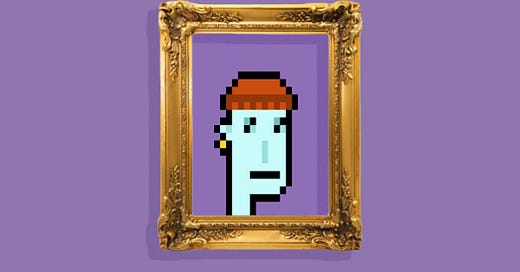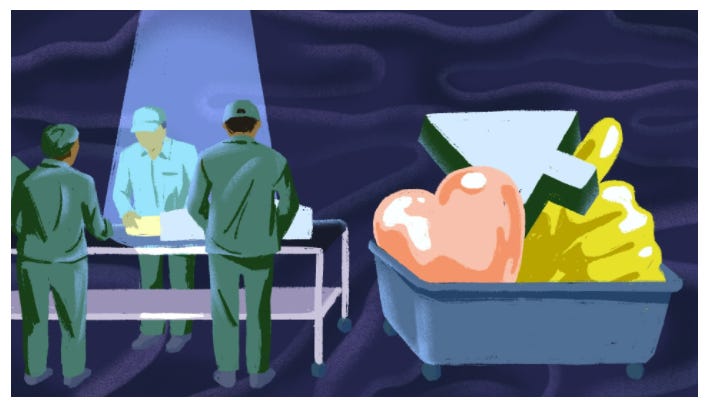In case you hadn't heard, pixel avatars are all the rage at the moment, but you may have to dig pretty deep into your pockets to snag one of the most valuable pieces. This week’s pieces also uncovered the history of China's decision making, how we can better support the creator economy, and how to better understand our own perspective on tech.
NFT parties
From AVC, by Fred Wilson
What has been slow to emerge about crypto, Fred points out, is the consumer opportunity. There is no wave to ride until you have a global consumer base of billions who are using the technology. It's a waiting game, hoping you won't fall off in the process.
Change is now slowly happening, but instead of this new consumer 'opening' emerging around the mainstream consumer experiences of online gaming, communities, and social networks (a natural space for early adopters) it is emerging around NFT experiences.
Last week, PartyBid organized an online party open to anyone and the 500 people who turned up ended up pooling their resources to lay their hands on a multi-million dollar CryptoPunk. 'The Party of the Living Dead' won the bid and then all changed their social profiles to the green pixel avatar. That's pretty cool.
PartyBid is cool. Axie is cool. TopShot is cool. NFT experiences are functioning around gaming, communities and social networks. While NFTs may not end up as the next big thing, Fred believes consumer experiences built with crypto and NFTs are leading the way.
Help support a creator economy in crisis
From Li’s Newsletter, by Li Jin
The gig economy. It was a major development in what it means to work, allowing workers greater freedom and flexibility. There were also downsides: income instability and reduced rights.
The passion economy, or creator economy, offered an alternative. Creators could monetize skills, knowledge and other unique services, connect with true fans, and make a living with as few as only 100 followers. In the US, there are over 50 million online micro-entrepreneurs.
Now, though, the negative sides of the gig economy are also seeping into the creator economy. Namely, the commoditization of work and the downfall of worker leverage. Social media platforms now act as gatekeepers for finding and connecting with fans. When creators are dependent on platforms, a great imbalance of power emerges.
Current risks include: over-supply and competition between creators, exploitation of creator labor, income insecurity and volatility (leading to creator burnout). Additionally, platforms are now middlemen in the economic relationship between creators and fans, deciding take rates and monetization criteria, which has led to great creator mistrust.
How to help build a healthier creator economy:
🔒 Ownership and portability: Creators now try to prioritize ownership: owning their communication with audiences (email, RSS feed), direct monetization (Stripe) and personal websites. Let’s allow creators and users to manage their own destiny with software that is community-owned and operated.
🔧 Credibly neutral creator mechanisms: “A mechanism that does not discriminate for or against any specific people.” Algorithms that make a choice on which content is shown is not neutral.
🗃 Creator-friendly business models: The content that users create is determined by the incentives offered by the business models. For example, if users were to directly pay creators, creators would almost certainly create different, still valuable, content.
🧑🤝🧑 Creator interdependence and solidarity: The current creator economy is one of competition; a battle between creators for passing attention. We should instead be helping creators mutually support and care for each other, to create spaces where people with a common mission harness the group's collective intelligence and resources.
NFTs as social networks
From Not Boring, by Packy McCormick
It seems a lot of people finally noticed similar avatars popping up across the internet last weekend. The one above is one of only 10,000 and, with NFT popularity soaring, these CryptoPunks are becoming more and more valuable. Back in March, the highest-priced Punk sold for 4.2k ETH. Currently it’s worth $7.57 million. Bottom line, owning a CryptoPunk is no different to owning a Ferrari, it's a status thing.
NFTs can be an extremely social and fun experience and, in this piece, Packy goes on to explore how Eugene Wei's Status-as-a-Service concept from successful social networks can also be applied to NFTs.
🐒 Two of Wei's principles are as follows: 1. People are status-seeking monkeys. 2. People seek out the most efficient path to maximizing social capital.
💰 NFTs make the line between financial and social capital somewhat foggy and purchasing digital images for millions of dollars certainly seems irrational at first. Those who reject NFTs miss the significance of social capital.
🔁 The strength of a social network rests on social capital, entertainment, and utility. The best networks have high utility and high social capital from the get-go. If you start with high social capital, you need to attempt to construct utility before you hit a proof of work ceiling or a social capital inflation/deflation.
Tech pessimist or tech optimist?
From Automatter, by Jeremy Diamond
How do you view tech?
👺 The Pessimistic Critic: A pretty rare specimen, but also a very easy spot as they are likely to announce themselves loud and proud. They enjoy fixating on the worst outcomes of technological change.
😁 The Optimistic Booster: Also easy to spot. In 2021, there are an abundance of positive stories. Optimistic Boosters enjoy telling inspiring tales of a triumphant future, which in turn breeds a great passion for their work.
😌 The Optimistic Critic: A little more level-headed. Always out to use power for good and make change happen. They understand the power of change and the power of choice which leads them to reminding others of their own accountability.
👹 Pessimistic Booster: Most difficult to spot. Often disguised as an optimist. In their eyes, the future does not concern change or choice, instead they advocate for the grim parts of the status quo continuing into the only possible future.
China's decision making explained
From Uncharted Territories, by Tomas Pueyo
The Hu Line, stretching from north-east China down to the south-west border, dictates much of the country's policy. From its intensifying relationship toward Taiwan and the occupation of Tibet to the Belt and Road initiative and the oppression of Uighurs. It all comes back to this line, or more specifically, to geography. 94% of China's population live east of this line (on 43% of its land). Why?
🌧 Rainfall: East China is the wettest area of the country and, together with winds from the east and ocean currents from the south, has incredibly fertile land.
⛰ Terrain: East China is the flattest area of the country. The Indian tectonic plate hits the Eurasian plate from the south, forming vast mountain ranges in the west.
So China is hyper-populated in the east, but why are the majority of them of Han ethnicity? 94% of its 1.4 billion people are Han. That's a very homogeneous population if you compare it to China's neighbor, India.
📜 Brief History of China: The Han come from the northern coastal plain, where the country's largest rivers flow into the sea. The land was the flattest, wettest and most fertile. Communication and trade was easy, making it the wealthiest area, hence its first kingdoms appeared 3,000 years ago. Wealth led to conquests, mainly towards the south. Soon the Han conquered all of east China and unified the land around 1,000 AD.
🏰 China's game of thrones: China's first priority, protect the northern plain. Its second priority, protect the whole eastern half. These two priorities explain a lot of China's history. The only thing that matters is Han territory, and protecting the Han.
Extra Reading
Pfizer and Moderna raise their prices to Biden’s dismay (From BIG, by Matt Stoller)
Caricatures causing anger in times of crisis (From Insight, by Zeynep Tufekci)
The spatial software framework, (From 1729, by John Palmer)
Personalized Health Insurance and the Payer Stack (From Out-of-Pocket, by Nikhil Krishnan)
Roblox deep dive: Gaming and the Creator Economy (From Creator Economy, by Peter Yang)
Apple’s plan to scan for CASM (From The Pull Request, Antonio Garcia Martinez)









